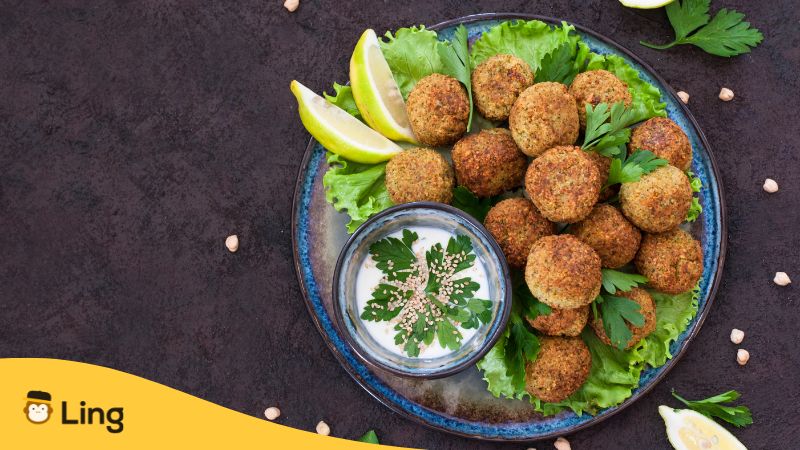Who doesn’t love delicious and spicy Arabic food? Though Middle Eastern cuisine is very famous for its meat dishes, you’ll find it has equally delicious vegetable dishes!
If you want to discover what’s behind these dishes, or if you want to try cooking some Arabic food at home, you should start by learning vocabulary for vegetables in Arabic. This way, you won’t have any problems when trying to describe what you’re looking for at a grocery store.
So, in this article, you’ll learn Arabic vocabulary for vegetables, plus a few delicious vegetable dishes as a bonus!
What’s The Arabic Word For Vegetables?
Before we get to the vocabulary tables, let’s learn how to say vegetable with the Arabic alphabet. The Arabic word for vegetable is khadar (خضار ). So if you want to buy some vegetables at a grocery store, you can ask an employee Ayne al-Khudrawat? (أين الخضروات؟ ), meaning “Where are the vegetables?” and they will show you the correct section.
The most favored vegetables in Arabic cuisine are potato, tomato, onion, and eggplant. They’re used as the base ingredients for almost all vegetable dishes, so make sure to pay attention to their names.
Root Vegetables In Arabic
Root vegetables are used in a variety of Arabic dishes, from stews to soups that warm the cockles of your heart on a cold winter day. Here are some of the most important ones:
Leafy Vegetables In Arabic
Leafy vegetables are not only used in salads in Middle Eastern cuisine. They can be served as a main dish, such as batenjen mehchi (stuffed eggplant), cauliflower shawarma, and dolma (stuffed grape leaves).
Mushrooms In Arabic Cuisine
You either love or hate mushrooms! I’m on the love side, and luckily, Middle Eastern cuisine has some delicious mushroom-based meals, such as mushroom shawarma.
Bulb Vegetables In Arabic Cuisine
Bulb vegetables are the backbone of every Arab food. If you want me to name a Middle Eastern dish that doesn’t include a bulb vegetable, I literally can’t name one. Though some people have sensitivity to onion and garlic, they add a fantastic aroma to dishes, especially meat dishes. Want some more similar cool information about the Middle Eastern food? Head straight to the Ling blog!
Traditional Vegetable Dishes In The Middle East
When we talk about Middle Eastern cuisine, most people think about kebabs and stews, which are very popular around the world. However, this cuisine has tasty vegetable dishes, too, which are less popular. Let’s see some traditional vegetable dishes in Middle Eastern cuisine!
1. Falafel – فلافل
For vegetarians, falafel is the number one alternative for meatballs. In essence, falafel is a dish that consists of mashed chickpea balls. It’s usually served with pita bread. They can be eaten as a main dish when served hot with a complementary mezze, or they can be a healthy snack when cold.

2. Manakish – مناقيش
Manakish is a delicious breakfast food, but I could eat it for three meals a day! In essence, manakish is a traditional breakfast bread baked with creamy cheese or za’atar seasoning on top and served with fresh veggies.
3. Dolma – دولما
Dolma has a place in many countries’ cuisines, from Turkish food to Jordan and other Middle Eastern countries. It’s often served as a warm starter or snack rather than a main dish. In essence, it consists of grape leaves stuffed with rice, veggies, and seasonings. However, some dolmas include meat, so if you are vegetarian, make sure to ask what’s inside before you take a bite.
4. Fattoush – فتوش
Fattoush is another vegetarian delicacy that comes from Middle Eastern cuisine. In essence, it includes sliced tomatoes and cucumbers together with onions and leafy greens. It’s served with pita bread.
5. Baba Ghanoush – بابا غنوج
Baba ghanoush is a flavorful mezze loved by all Arab people. In essence, it’s a mix of mashed eggplant, tahini, and finely chopped vegetables complemented with pomegranate molasses.
Wrapping Up
I hope you benefit from this article, especially if you’re a vegetarian or vegan traveling to the Middle East. As you’ve read in this article, Middle Eastern cuisine is not all about meats. You may prefer to go to a grocery store and use the vocabulary you’ve learned here to buy some fresh vegetables and cook them at home, or go to a local restaurant and order a vegetable dish. We’ve only mentioned five dishes here, but there are many more! So, in conclusion, you don’t have to worry about what to eat during your Middle East trip if you prefer to avoid meat!



































































